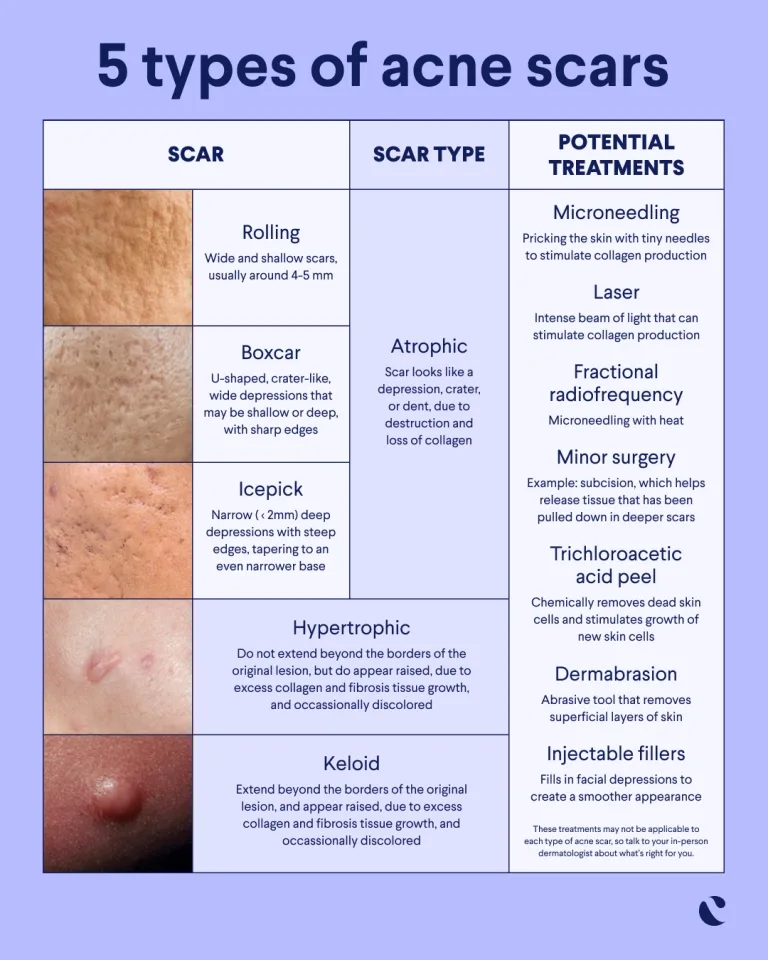How it works:
Share your skin goals and snap selfies
Your dermatology provider prescribes your formula
Apply nightly for happy, healthy skin
How it works:
How it works:
Share your skin goals and snap selfies
Your dermatology provider prescribes your formula
Apply nightly for happy, healthy skin
How it works:
What are hypertrophic scars and what causes them?
After a wound heals, hypertrophic scars can be left behind—the result of excess collagen deposition.



Skin wounds can result in scars, but did you know that there are different kinds of scars? Hypertrophic scars are known for being firm and raised above the skin’s surface.¹ They can be frustrating, but fortunately, there are ways to help prevent and treat them to help improve their appearance.
Here, we’ll aim to explain what causes hypertrophic scars, highlight characteristics that differentiate them from other scar types, and provide a list of practical ways to help prevent and treat them.
What are hypertrophic scars, and how do they form?

Hypertrophic scars are raised scars that can form during the wound healing process. They develop from an abnormal and exaggerated healing response where the body produces an excess amount of collagen, which settles in a haphazard, whorl-like way.² Hypertrophic scars differ from keloid scars because they stay within the original injury boundary, whereas keloid scars do not.
Hypertrophic scars can develop when excess tension pulls at a wound closure, after a burn, or after other types of skin injury. This type of scar can occur anywhere on the body. It begins to appear about eight weeks after injury and can occur in men and women of all ages. However, people between the ages of 10 and 30 tend to be most susceptible. Younger people have more tension in their skin and produce more collagen, an ability our bodies gradually lose as we age.³
Characteristics of hypertrophic scars
Hypertrophic scars are typically raised, red, and nodular, occurring in areas of thick skin and over joints like the elbow and knee. They develop about eight weeks after the initial injury, growing rapidly for about six months. In some cases, they improve about 12-18 months later.⁴
Other common characteristics of hypertrophic scars include:
Red and raised. Hypertrophic scars are often red, raised, and nodular. In some cases, they can become flatter with time.
Forms within the boundaries of the wound. This is different from keloid scars, which extend outside the wound boundaries.
Creates thicker tissue. During the healing process, the tissue is thicker because of excess collagen fibers over the wound.
Restricts movement. When hypertrophic scars develop over joints, they can limit movement. The skin loses flexibility in the area of the scar. The same is true no matter where the scar forms. Restriction is just in the form of skin movement rather than joint movement.
Hypertrophic scars vs. keloid scars
A hypertrophic scar is a raised scar confined within the boundaries of the injury. This differs from a keloid scar that forms above the skin’s surface beyond the edges of the original wound. Both scar types develop from an excess of collagen formed during the healing process, and both can be itchy and painful. Another difference is that in some cases hypertrophic scars flatten or fade over time, but keloid scars don’t go away without treatment.⁵
Here’s how to tell the difference between hypertrophic and keloid scars:

Hypertrophic scars:
Appear raised, pink or red in color
Most common on areas of thickened skin
Develop about eight weeks after injury
May begin to flatten about 12-18 months after the injury
Keloid scars:
Appear raised, pink, purple, or darker in color
Occur more often in people with darker skin tones
Often develop on the earlobes, shoulders, and upper chest
Develop over time, often showing up months after the injury
Do not enter the final wound healing stage and do not go away on their own
Risk factors to watch out for
Not every wound will scar, but almost everyone has experienced a wound that has resulted in scarring. Scars can form as part of the healing process. In the skin, collagen production helps heal and repair the wound. When too much collagen is produced during the healing process, the new tissue can be thick and less flexible. Some skin conditions that may lead to scars include acne and chickenpox, but any skin condition that results in blemishes can theoretically leave a scar in its wake.
Here are some other contributing factors to developing hypertrophic scars—or any scar:
Burns. Second-degree and third-degree burn injuries can result in hypertrophic scars. These burns damage the dermal layers of the skin.
Poor wound healing. Scars can form due to infection or poor wound repair.
Genetics. Skin prone to raised scars can be hereditary. This is especially true with keloid scars,⁶ which can even be caused by piercings.
Where do hypertrophic scars occur?
Hypertrophic scar formation can occur anywhere on the body, but they typically appear over areas of thicker skin or where there is increased skin tension. This includes the back, chest, and upper arms. The skin covering bony or soft tissue prominences is also prone to hypertrophic scarring.⁷
Although visible and sometimes itchy and painful, hypertrophic scars are neither dangerous nor a precursor to cancer. That said, depending on where the scar is, many people seek treatment from a dermatology provider to minimize the appearance or hurry the healing process—especially when it comes to getting rid of acne scars.
How can I treat my hypertrophic scar?

There are many hypertrophic scar treatments you can try to see what works for you, including those performed by a medical provider as well as home treatments. What you choose will depend on how well your skin responds to scar management modalities, where on your body the scar is, and how you feel about the scar. Just keep in mind that if you have a keloid scar, it will require treatment from a medical professional. When it comes to acne, prevention is the best way to avoid any type of scars, and that begins with appropriate skincare, including cleansing, treating, and moisturizing.
Treatment of hypertrophic scars includes:
Corticosteroid treatments. Corticosteroid injections administered by your medical provider about every six weeks can help soften the scar. The downside is that steroid injections can lighten and thin surrounding tissue.
Cryotherapy. This is a type of localized treatment where a dermatology provider uses liquid nitrogen to freeze the scar tissue. This has been successful with keloids and hypertrophic scars. Side effects can include mild pain, increased recurrence rates, and depigmentation, but all appear to be uncommon or temporary.⁸
Pressure and massage therapy. Simply applying a pressure bandage and performing a massage in the scar area may diminish its appearance. Wear pressure bandaging or tape until the scar is mature. This can weaken the scar tissue over time.⁹
Silicone gel. Many consider this to be the most noninvasive home treatment for scars. They’re also often thought of as the first line of defense, as silicone sheets can be applied as soon as the skin closes. Silicone products include hypertrophic scar creams, silicone gel sheeting, sprays, and foams.
Can Curology treat acne scars?
The best way to treat acne scars—or any scars—is to prevent them. Here’s where Curology comes in. We don’t treat scars specifically, but we do use proven treatment options, expert guidance, and convenient service to help treat and prevent the type of acne that may result in scarring. We’re a service-first brand ready to help you through your skin-related challenges.
Get your personalized skincare routine with Curology
Get your personalized skincare routine with Curology


So, if you’re dealing with acne breakouts and concerned about potential scarring, sign up for a free trial of Curology to get paired with one of our licensed dermatology providers. They’ll be with you every step in your journey to ensure your skincare routine and the products you use are right for you. With your free 30-day trial, you’ll receive a personalized prescription formula by Curology and other recommended skincare products delivered to your door—just pay $5.45 for shipping and handling.*
Get your personalized skincare routine with Curology today.
More than nine out of 10 Curology members see clearer skin within 90 days!**
FAQs
Hypertrophic scars are raised scars that can form during the wound healing process. They develop from an abnormal and exaggerated healing response where the body produces an excess amount of collagen, which settles in a haphazard, whorl-like way.
Hypertrophic scars can develop when excess tension pulls at a wound closure, after a burn, or after other types of skin injury. This type of scar can occur anywhere on the body. It begins to appear about eight weeks after injury and can occur in men and women of all ages.
A hypertrophic scar is a raised scar confined within the boundaries of the injury. This differs from a keloid scar that forms above the skin’s surface beyond the edges of the original wound. Both scar types develop from an excess of collagen formed during the healing process, and both can be itchy and painful. Another difference is that in some cases hypertrophic scars flatten or fade over time, but keloid scars don’t go away without treatment.
Hypertrophic scar formation can occur anywhere on the body, but they typically appear over areas of thicker skin or where there is increased skin tension. This includes the back, chest, and upper arms. The skin covering bony or soft tissue prominences is also prone to hypertrophic scarring.
P.S. We did the homework so you don’t have to:
American Academy of Dermatology. Scars: Signs and symptoms. (n.d.).
Zurada, J.M., et al. Topical treatments for hypertrophic scars.Journal of the American Academy of Dermatology. (2006, September 19).
Rabello, F.B., et al. Update on hypertrophic scar treatment.Clinics. (August 2014).
Zurada, J.M., et al. Topical treatments for hypertrophic scars.Journal of the American Academy of Dermatology. Ibid.
American Academy of Dermatology. Scars: signs and symptoms. (n.d.).
American Academy of Dermatology. Keloids: Who gets and causes. (n.d.).
Schmieder, S.J., et al. Hypertrophic scarring.StatPearls. (2021, September 9).
O’Boyle, C.P., et al. Intralesional cryotherapy for hypertrophic scars and keloids: A review. Scare, Burns and Healing. (2017, April 17).
Zurada, J.M., et al. Topical treatments for hypertrophic scars. Ibid.
* Subject to consultation. Subscription is required. Results may vary.
** Disclaimer: *In a clinical trial of 150 Curology patients. 95% saw improvement after 12 weeks. Self-reported.

Curology Team

Meredith Hartle, DO
Related Articles
25 skincare myths debunked: what you need to knowAsk a skin expert: Your skin’s damaged skin barrierWhat’s causing your skin irritation and how to stop itForehead acne: what’s up with that?How to treat dry, flaky skin and rosaceaPopular Articles
Ask Curology: Is my cold breaking me out?Slugging: The dermatologist-approved skincare hack going viral on TikTokTretinoin vs retinol: What’s the difference?How to create a self-care routine that actually sticksYour 2023 skincare horoscopeTry prescription skincare
Get routine essentials


Get clearer skin with Custom FormulaRX
Get clearer skin with Custom FormulaRX
- Breakouts
- Clogged pores
- Whiteheads
- Redness
- Blackheads
$29.95/month